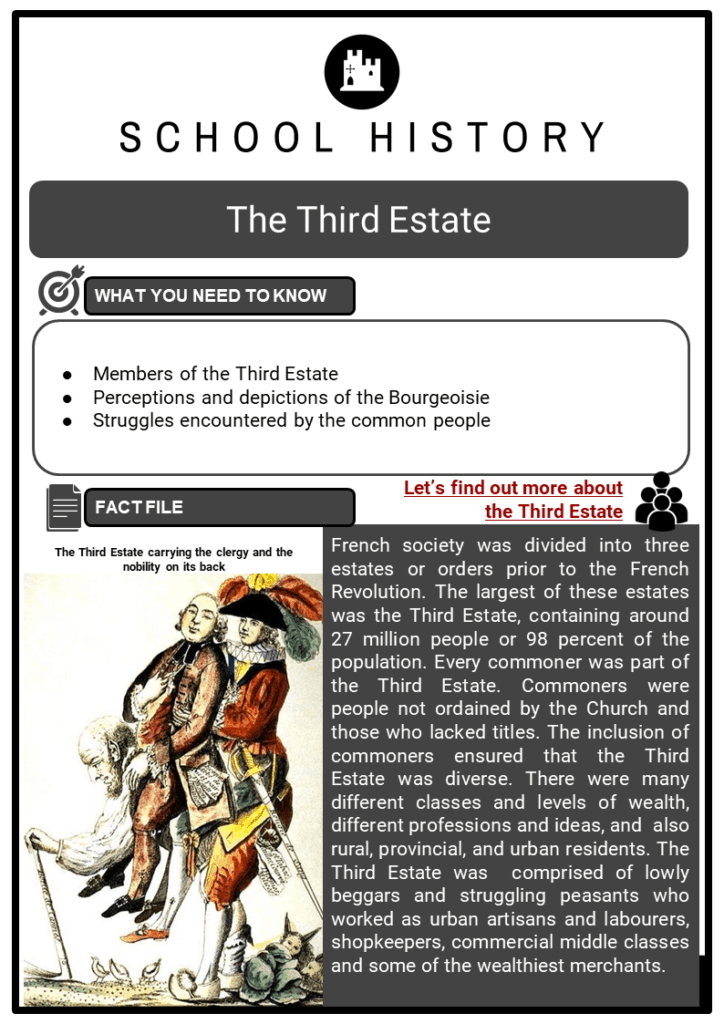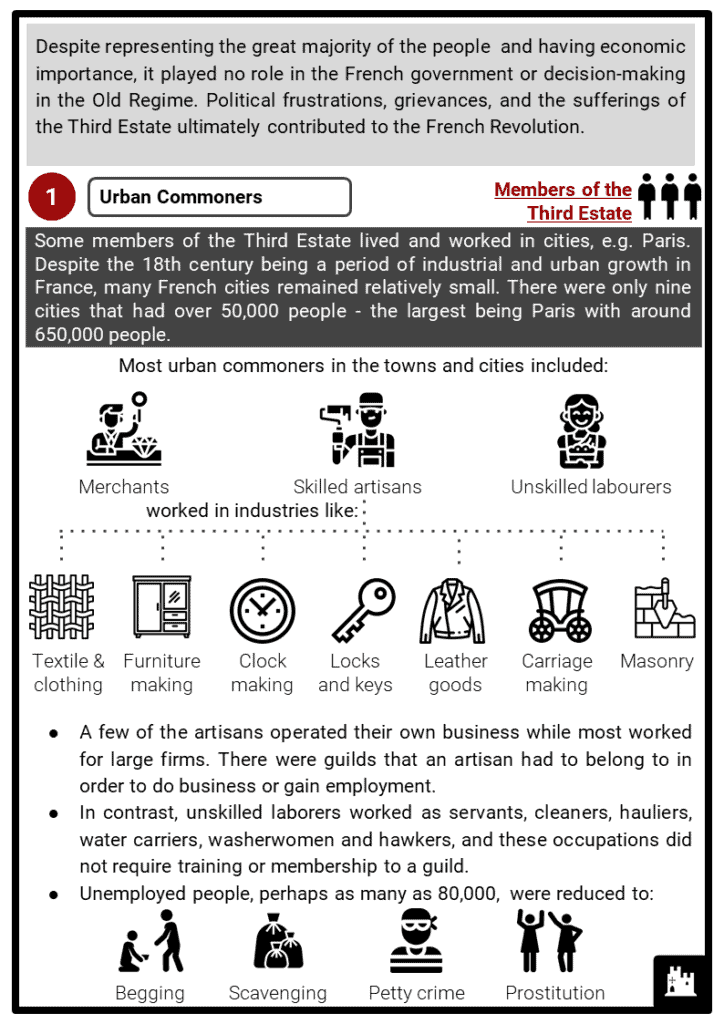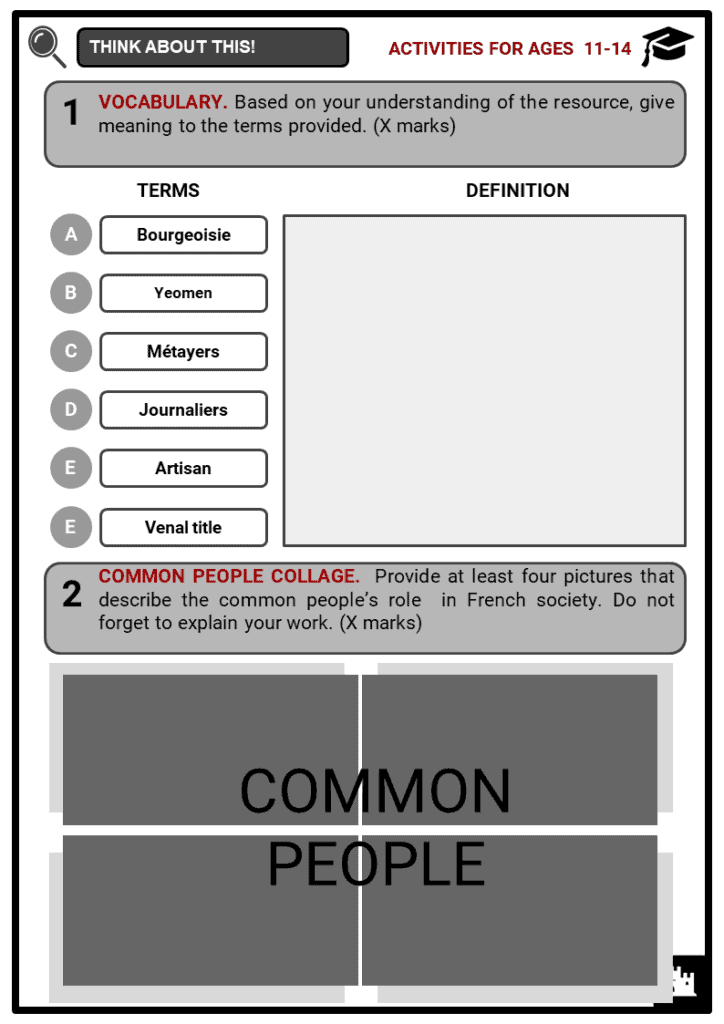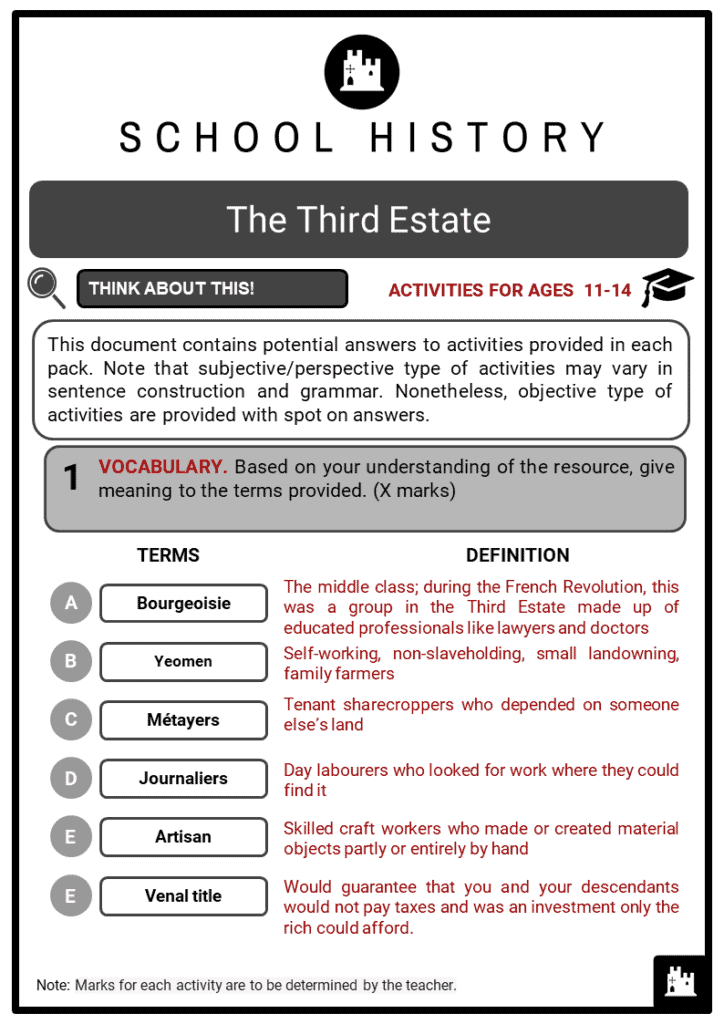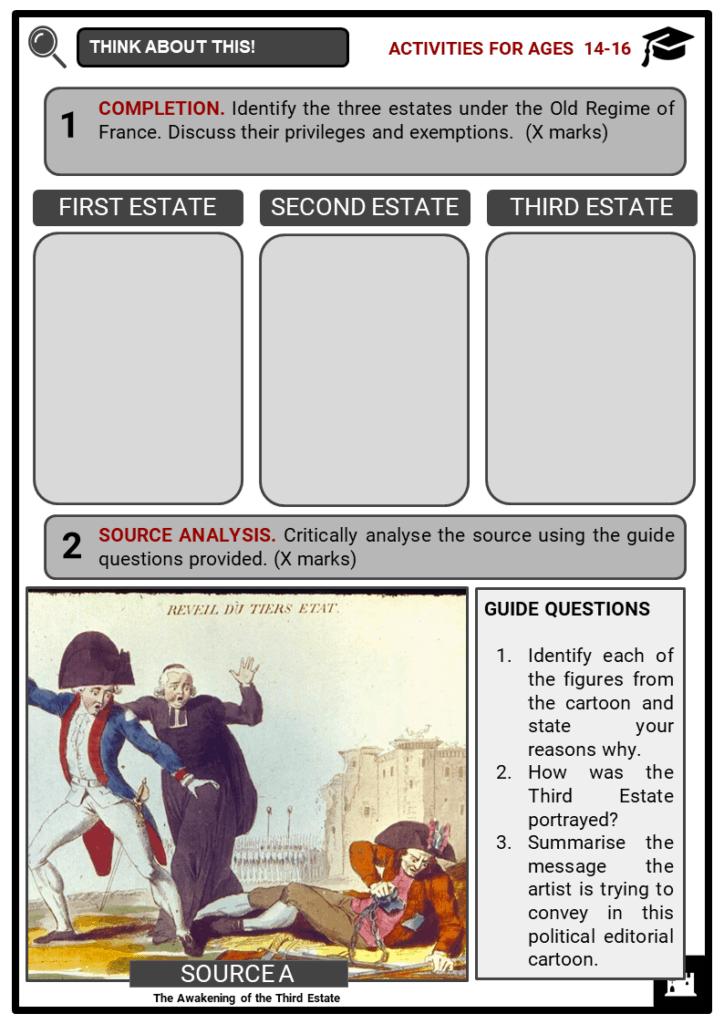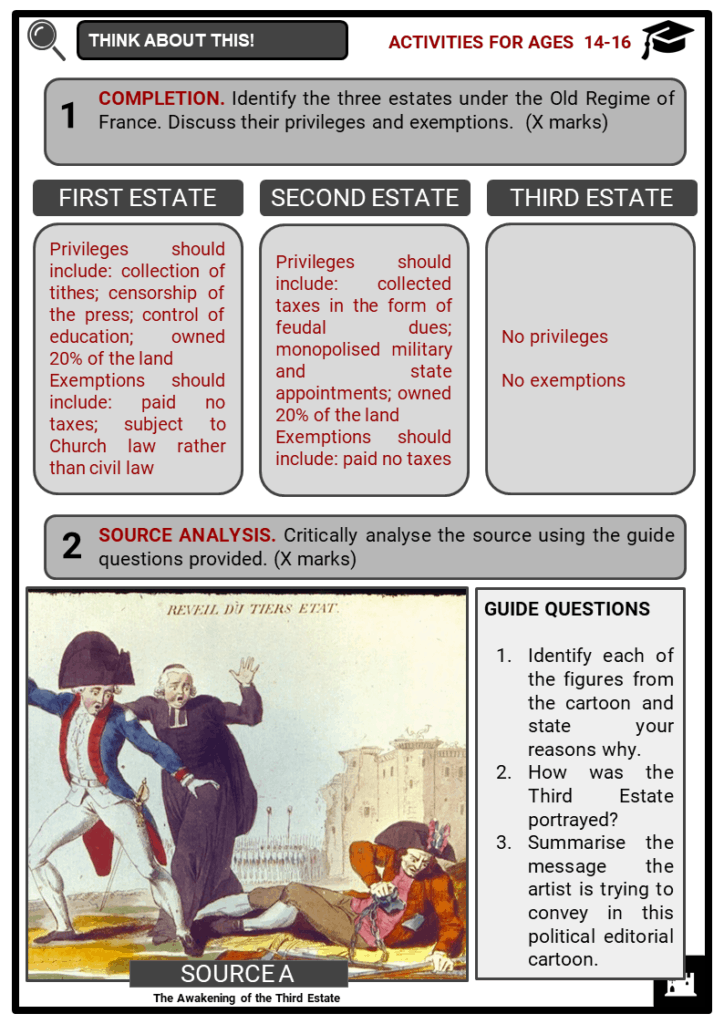Download The Third Estate Worksheets
Do you want to save dozens of hours in time? Get your evenings and weekends back? Be able to teach The Third Estate to your students?
Our worksheet bundle includes a fact file and printable worksheets and student activities. Perfect for both the classroom and homeschooling!
Table of Contents
Add a header to begin generating the table of contents
Summary
- Members of the Third Estate
- Perceptions and depictions of the Bourgeoisie
- Struggles encountered by the common people
Key Facts And Information
Let’s find out more about the Third Estate
- French society was divided into three estates or orders prior to the French Revolution. The largest of these estates was the Third Estate, containing around 27 million people or 98 percent of the population. Every commoner was part of the Third Estate. Commoners were people not ordained by the Church and those who lacked titles. The inclusion of commoners ensured that the Third Estate was diverse. There were many different classes and levels of wealth, different professions and ideas, and also rural, provincial, and urban residents. The Third Estate was comprised of lowly beggars and struggling peasants who worked as urban artisans and labourers, shopkeepers, commercial middle classes and some of the wealthiest merchants.
- Despite representing the great majority of the people and having economic importance, it played no role in the French government or decision-making in the Old Regime. Political frustrations, grievances, and the sufferings of the Third Estate ultimately contributed to the French Revolution.
Members of the Third Estate
Urban Commoners
- Some members of the Third Estate lived and worked in cities, e.g. Paris. Despite the 18th century being a period of industrial and urban growth in France, many French cities remained relatively small. There were only nine cities that had over 50,000 people - the largest being Paris with around 650,000 people.
- A few of the artisans operated their own business while most worked for large firms. There were guilds that an artisan had to belong to in order to do business or gain employment.
- In contrast, unskilled laborers worked as servants, cleaners, hauliers, water carriers, washerwomen and hawkers, and these occupations did not require training or membership to a guild.
- Unemployed people, perhaps as many as 80,000, were reduced to:
The Peasantry
- Peasants lived in the bottom tier of the Third Estate’s social hierarchy and formed between 82 and 88 percent. Peasant-farmers were France’s poorest social class.
- Most of them worked as feudal tenants or sharecroppers and were required to pay a range of taxes, tithes, and feudal dues.
- Given that there were different levels of wealth and income, it is acceptable to assume that the majority of the French peasants were poor.
- A very small population of peasants owned land in their own right and had the capacity to live independently as yeoman farmers.
- Métayers were tenant sharecroppers who depended on someone else’s land. Journaliers were day labourers who looked for work where they could find it.
- Whatever the peasants were experiencing in life, all of them were heavily taxed by the government. Feudal tenant peasants were also asked to pay dues to their local seigneur or lord. If they were part of a parish, they were required to pay a yearly tithe to the church.
- All these tax obligations were rarely relaxed, even during challenging times such as poor harvests, when most peasants were pushed to the edge of starvation.
The Affluent Bourgeoisie
- At the top of the Third Estate’s social hierarchy was the bourgeoisie.
- Wealthy businessmen, the bourgeoisie or the capitalistic middle classes, did not suffer as much as the artisans and unskilled labourers. Through their businesses, the bourgeoisie were professionals who had acquired enough wealth to live comfortably.
- There was social stratification among the bourgeoisie as there was also diversity within their ranks.
- Petit Bourgeoisie
- Also known as ‘petty’ or ‘small bourgeoisie’, which was sometimes perceived as derogatory
- Composed of:small-scale traders, landlords, shopkeepers, managers.
- Haute Bourgeoisie
- Also known as ‘high bourgeoisie’
- Composed of: wealthy merchants and traders, colonial landholders, industrialists, bankers, financiers, tax farmers, professionals.
- These people prospered during the 1700s due to France’s economic growth, modernisation, increased production, imperial expansion, and foreign trade. The status of the Haute bourgeoisie rose from the middle class as they became independently wealthy and well-educated.
Perceptions and depictions of the Bourgeoisie
Political Aspirations
- This was marked by their exodus as they joined the Second Estate and improved their social status and political representation.
- They lacked titles, privileges, and prestige but had enough money to acquire the costumes, trappings, and grand residences of the noble classes.
- The only way the wealthiest of the bourgeoisie could gain nobility was by buying it through venal offices, though by the 1780s this was becoming very expensive.
- The frustrations of the bourgeoisie were compounded by the rising prices of venal titles as this thwarted their social and political aspirations.
- The Haute bourgeoisie helped in building France’s economy, yet the government excluded them from policymaking as they left that to the exclusive domains of the royal court and its noble favorites.
The Revolutionary Bourgeoisie
- Many educated bourgeoisie tried to push for reforms through Enlightenment tracts.
- These Enlightenment tracts challenged the foundation of monarchical power and argued that government should be representative, accountable, and based on popular appeal.
- A book published in January 1789 by Emmanuel Sieyes titled, “What is the Third Estate?” struck a chord with the self-important bourgeoisie, who believed they were entitled to play a role in government.
- This book was not the only expression of this idea as there was a flood of similar pamphlets and essays circulating the nation in early 1789. These documents had the flaw of speaking only of the bourgeoisie and disregarding other members of the Third Estate.
- The peasants and urban workers were politically ignored by the bourgeoisie just as the bourgeoisie was, itself, politically ignored by the Old Regime.
Struggles encountered by the common people
The Difficult 1780s
- By the 1780s, the lives of urban workers, both skilled and unskilled, was becoming increasingly difficult.
- Parisians worked for meagre wages, which were between 30 and 60 sous a day for skilled labourers and between 15 and 20 sous a day for unskilled laborers.
- Before 1789, wages had risen by around 20 percent, however, food prices and rents had increased by 60 percent in the same period, resulting in financial hardship.
- Parisian workers were struggling to keep up with skyrocketing bread prices. The price of a four-pound loaf of bread increased from 9 sous to 14.5 sous by early 1789.
- Many families crammed into shared attics and dirty tenements, mostly rented from unscrupulous landlords. As the rents could cost a whole day’s wages, most workers economized by sharing accommodation.
- Many rooms housed between 6 and 10 people, though 12 to 15 per room was also common. The living conditions in these tenements were horrific. They were cramped, unhygienic and uncomfortable, and there were no toilet facilities, heating or plumbing. Water was fetched by hand from communal wells and people relieved themselves in open sewers.

